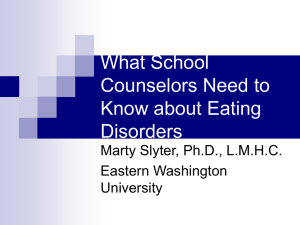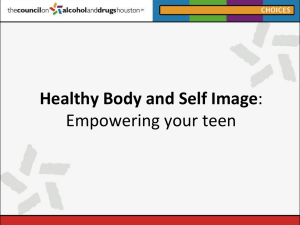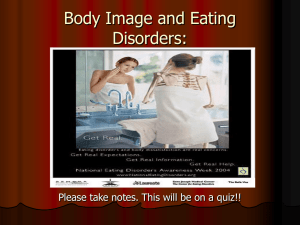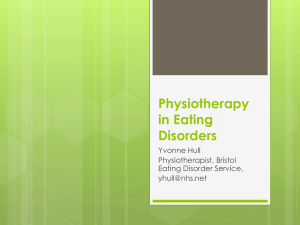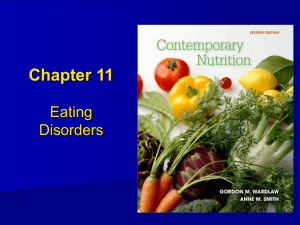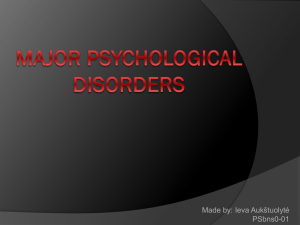Multi-impulsive Eating Disorders
advertisement
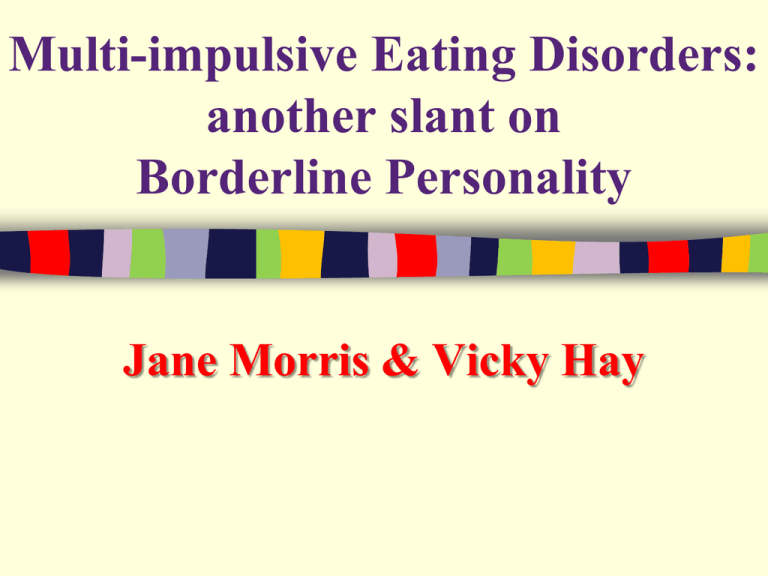
Multi-impulsive Eating Disorders: another slant on Borderline Personality Jane Morris & Vicky Hay OVERVIEW: What is the relationship between eating disorders and personality disorders? Why does it matter? What is it like to experience ‘multiimpulsive eating disorder? How can we help? What is the relationship between disorders and personality? Personality patterns may make people more vulnerable to a particular range of illnesses – ‘type A’ personality and heart disease, perfectionists and anxiety disorders etc Particular disorders may shape personality – people with chronic illnesses often become carers, children with dyslexia may develop rule-breaking or highly creative personalities What is the relationship between eating disorders and personality? Do particular personality patterns predipose a person to develop an ED? Does the experience of suffering from an ED influence the development of personality? Do particular personality structures determine the nature of the eating disorder experienced by the sufferer? Eating disorders ? Anorexia nervosa (since 15th century) Low weight obsessively achieved because of fear of fatness. 2 subtypes AN-R and AN-BN Bulimia nervosa (since 1970s – Russell et al) Attempted weight loss by starvation leads to vicious cycle of restriction/binge/purge at normal weight Binge eating disorder (since 1980s and 1990s) Binges and periods of attempted restriction but without other compensatory behaviours – often overweight Co-morbidity with eating disorders Anorexia often found in individuals – and families – who also show OCD, anxiety disorders, ASD Bulimia often seen with depression, substance abuse So-called ‘axis II disorders’ also tend to cluster in similar ways – obsessivecompulsive PD with AN, impulsive PD with Bulimic type illnesses DSM-IV personality disorders Cluster A – ‘odd’ eg schizotypal PDs B – flamboyant, histrionic, narcissistic, borderline Cluster C – avoidant, rigid, obsessessional Cluster DSM–IV (APA, 1994 Diagnostic criteria for borderline personality disorder At least five of: Intense and unstable personal relationships Frantic efforts to avoid real or imagined abandonment Identity disturbance or problems with sense of self Impulsivity that is potentially self-damaging Recurrent suicidal or parasuicidal behaviour Affective instability Chronic feelings of emptiness Inappropriate intense or uncontrollable anger Transient stress-related paranoid ideation or severe dissociative symptoms Research on Eating Disorders and personality disorders: 1988 Powers et al 77% BN patients 1989 Garner et al 61% BN patients 1990 Schmidt & Telch 43% BN patients 1994 Steiger et al 28% BN patients ...met diagnostic criteria for at least one personality disorder (DSM IV, APA 1994) Research on Eating Disorders and personality disorders: Braun et al, 1994 found that 69% all ED patients had at least one PD Of those with bulimic subtypes, 31% had a Cluster B Personality Disorder – mostly borderline type NONE of the purely restricting anorexic patients had a cluster B personality Disorder Cluster C personality disorders spread evenly across all types of ED Research on Eating Disorders and personality disorders: 1992 Hertzog (210 patients) found that the commonest PD to be associated with an ED is borderline type 2000 Matsunya studied patients recovered from EDs. 26% had at least one PD. Cluster B strongly associated with bulimic subtypes Two extremes of eating disorders and broadly two ‘groups’ in our service 1- ‘STABILITY’ Those who relieve anxiety and guilt by means of avoidance and rituals of sameness (obsessive compulsive behaviours). Strong attachment to the disorder – other people seen as obstacles to or protectors of the disorder 2 - ‘INSTABILITY’Those who relieve intolerable emotions – anxiety, boredom, shame – by means of ‘acting out’ behaviours often involving risk-taking (impulsive or borderline). Strong but insecure attachments to other people – disorder serves to communicate perceived needs, albeit maladaptively MULTI-IMPULSIVE BULIMIA (Lacey, 1993) Bulimia nervosa + at least 3 of the following: Heroin, LSD, amphetamines, street tranquillisers Abuse of alcohol Stealing/ shop lifting self harm – Overdoses, selfcutting or burning And frequently ‘promiscuous sexual behaviours’, inability to be truthful Why does this matter? Attempts to work therapeutically with people with EDs depend crucially on development of a respectful therapeutic relationship Understanding attachment styles and personality profiles is helpful in formulating reasonable expectations of people in treatment Those working to help people with personality disorders need to be aware of the effects of starvation and the results of other eating disordered behaviours on the capacity to learn Why does this matter? People engaging in weight-losing behaviours display many more behaviours than food restriction Paradoxically, whilst these attempts to control weight are attempts at control and stability, in fact they lead to increasing amplifications of instability and make it harder and harder for people to learn ordinary skills for coping with life or attracting help from other people Self-induced vomiting Chewing & spitting out Medication abuse - Appetite suppressants – including gum, cigarettes - alternative, OTC & www medications – laxatives, ipecac, pain killers to allow exercise despite damage Overexercise – often secret, obsessive housework Overactivity – ‘fidgetting, twitching, never sitting down, fetching one item at a time Cooling – inadequate dress, open windows etc ‘Body-checking’– both when alone and in terms of comparisons with others - and body image avoidance Spoiling or messing of food, bizarre combinations Cruising ‘pro-ana’ websites/emailing fellow sufferers THESE ARE NOT JUST HANDICAPS TO WEIGHT GAIN THEY DAMAGE QUALITY OF LIFE , MAINTAIN THE DISORDER – AND MIMIC PERSONALITY DISORDER Effects of eating disorders on the brain Hypoglycemia – chronic ‘restrictors’ show adaptation – not so for those who bingepurge, where rapid swings in glu levels act like drug highs and withdrawal Hypoglycemia mimics symptoms of anxiety, and loss of K+ and Mg++ makes people even more nervous and twitchy Starvation makes us aggressive – difference between hunger and anger often hard to discriminate – and utterly preoccupied with food Eating disorders and self harm DSH as primary? For some patients self-starving is a form of self-harm and may replace the ‘need’ for cutting, overdosing etc. Body image gratification may then ensue and become a perpetuating factor ED as primary? Others resort to these other forms of self-harm for the first time if their anorexia is ‘taken away from them’ or if they ‘break the rules’ themselves. For some patients this is ‘neutralising’ behaviour, whilst for others it is a communication of protest Some patients remain natural restrictors all their lives, unable to achieve any peace of mind unless they take constant control But for the majority, with age and the passage of time, ‘graduation’ is from restricting anorexia to bulimic type anorexia, to normal weight bulimia and also then to other forms of self-harm Auto/biographical literature Alice in the Looking Glass The Best Little Girl in the World Stick Figure My Hungry Hell Wasted Wounded: Fighting my Demons What does it feel like to experience a multi-impulsive eating disorder? Vicky Hay, author of ‘Wounded: Fighting my Demons’ What might be helpful? CBT? Formulates binge-purge episodes in terms of a vicious cycle of restraint > binge >purge +further restraint> bigger binge> purge etc etc IPT-BN? Formulates binge-purge episodes in terms of failure to cope with interpersonal incidents DBT? Formulates DSH and eating disordered behaviour in terms of failure of emotional regulation and distress tolerance What can help? Importance of Physiological stability intrapsychic and interpersonal aspects and of the therapeutic relationship CBT Beck, 1979, Fairburn, Waller Links physical, emotional and cognitive aspects of experience Psychoeducation – what is going wrong at present and what will be expected during the course of therapy? Establishing of stable pattern of 3 meals & 3 snacks daily, weekly weight recorded on graph Getting rid of binge-purge behaviours and using problem solving, thought challenging and other cognitive techniques to cope with emotional and interpersonal difficulties But 50% patients not helped by CBT-BN alone IPT Klerman & Weissman, Fairburn Fairburn’s model of IPT actually turns its back on the eating disorder behaviours! Interpersonal inventory Grief, conflict and disputes, transitions Identifying and tolerating emotion and feeling Role play and creative development of interpersonal skills for getting the best out of relationships and protecting self from destructive patterns of relating Coping with endings and goodbyes DBT Linnehan, 1993, Palmer Intense, irreverent therapeutic relationship, exploitation of the attachment Individual and group therapies in parallel Focus on not unwittingly reinforcing selfdestructive behaviour Skills: mindfulness, distress tolerance, emotional regulation, interpersonal skills Chain analysis of painful incidents DBT for eating disorders Palmer et al 2003 (n=7) fewer days in hospital, reduced DSH ‘eatingness’ Maltheus, Allen, Reid & Linehan 2008 (n=8) BN and BED Stanford model of DBT for BN (1RCT) & BED (2RCTs) – similar results to CBT and IPT trials - Mindful vs mindless eating - Urge surfing vs capitulation - ‘apparently irrelevent behaviours’ Sometimes Sometimes things don't go, after all, from bad to worse. Some years, muscadel faces down frost; green thrives; the crops don't fail. Sometimes a man aims high, and all goes well. A people sometimes will step back from war, elect an honest man, decide they care enough, that they can't leave some stranger poor. Some men become what they were born for. Sometimes our best intentions do not go amiss; sometimes we do as we meant to. The sun will sometimes melt a field of sorrow that seemed hard frozen; may it happen for you. Sheenagh Pugh
